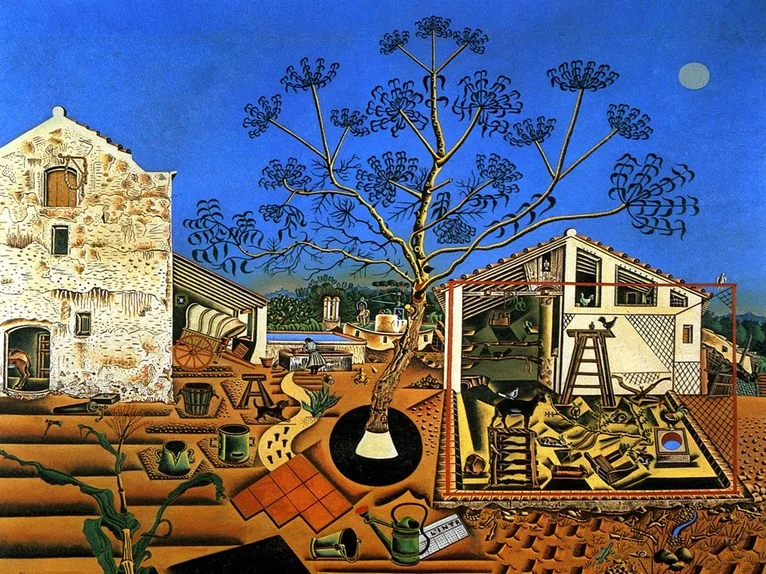Joan Miró: Studio as Home
Between Earth and Sky
"You must always plant your feet firmly on the ground if you want to be able to jump in to the air." —Joan Miró to James Johnson Sweeney, as quoted in Miró, by Jacques Dupin
"Trample the earth when painting, for strength enters through your feet." —Joan Miró to gallery owner and friend, Jacques Dupin
It is true that Miró would turn to nature for inspiration in his works. If the shapes and lines of his paintings disguise some of the natural elements, one can still admire the poetry of this natural inspiration from his painting titles: The Bird Dives toward the Lake in Which Stars are Reflected; Drops of Water on the Pink Snow; Rhythm of the Passing Snake Carried Along by the Blowing Hair Let Down at Sunset; The Red Sun Gnaws at the Spider. Situated within the mountains at his family farm at Mont-roig ("red mountain" in Catalan), and the ocean of Majorca (also known as "island of the calm"), Miró would come to produce some of his most monumental works.
To Crouch Before Jumping: Preparation and Order
One might look to Miró's assertion that in order to jump one must first press into the earth as a statement of his methods. In the opening chapter of Miró's biography, Jacques Dupin draws a connection between the mechanisms of the earth and those of Miró. Of the earth, he writes:
For the earth does not only inspire, it also corrects; it supplies energy and stimulates movement, but it dictates direction and imposes coherence as well. Nature's superabundance is not a squandering of energies, but an ordered profusion, subject to cycles, governed by rhythms.
Of Miró, he writes:
Deeply imaginative by nature, Miró mistrusted so-called fantasy, caprice, the inspiration of the moment and other such things that pass for imagination. He had banished them from his life and from his work by subjecting himself to a regime of the strictest discipline and organization. Nothing was left to chance, not even in his daily habits: there was a time to take a walk, there was a time to read, there was a time to be with his family, and there was a time for work.
Discipline and organization manifest themselves in the mundanity of routine. Miró's system of organization seems to have fueled his creative energies by providing order and clarity. Again, Dupin explains:
In his studio, order and tidiness ruled despotically. Canvases were neatly stacked and filed according to a complicated system known only to the artist; drawings and sketches were dated, classified, annotated and stored in the appropriate dust-proof boxes. Brushes were cleaned as soon as used and arranged according to size. Bottles were neatly labeled; tubes of paint were laid out in strict order. On the table where he worked, the pencils, the erasers, and the penknife had their appointed places. I had often seen him, bent over a sheet of paper, methodically flick off a grain of dust that had just alighted on it.
The Leap Into Sky: Imagination
These methods may have served as the firm footing from which to jump into the air:
We may suspect that his excessive orderliness had a purpose, and that it was to dam up his surging creative energies, so that they could be better directed onto the rectangle of canvas or paper, with no other outlet.
This dichotomy between earthly discipline and "aerial poetry," as Dupin so beautifully phrases it, may be best represented by one of Miró's first masterpieces, The Farm.
In The Farm, Miró meticulously records an inventory of space and home. It is with the precision of a surveyor that he records the details. From sprouts and snails to the cracks in the house, everything has its place on the land. As Dupin notes, however, everything also seems to "work its way upwards." The objects push into the earth as a way of reaching into the sky.
If Mont-roig symbolizes Miró's grounding methods, his studio and home in Majorca might represent the goal of such meticulousness: vision, imagination, clarity. While the methods might "[dictate] direction and impose coherence," the purpose is for those moments one finds oneself mid-air in the jump. In this sense, to trace Miró's paintings is to trace the jumps that surged from the toil of work.
For a visit to Miró's Mont-roig and Majorca studios, and for accounts from friends and family on Miró's methods and dispositions, watch the short biography below (15:51).
Additional Resources
Friend of Miró and family, Jacques Dupin, was asked by Miró to write a monograph of the painter's work as an accompaniment to the first catalogue of Miró'spaintings. Originally published in 1961, Dupin drastically updated the publication by including accounts from Miró's sketchbooks, letters, and other documents after Miró's death. All of the quotes mentioned here are derived from Miró, by Jacques Dupin.
*Frontispiece
Joan Miró (1921-22), The Farm, oil on canvas, 48 3/4 x 55 5/8 x 1 5/16 inches, National Gallery of Art, Washington, D.C.






